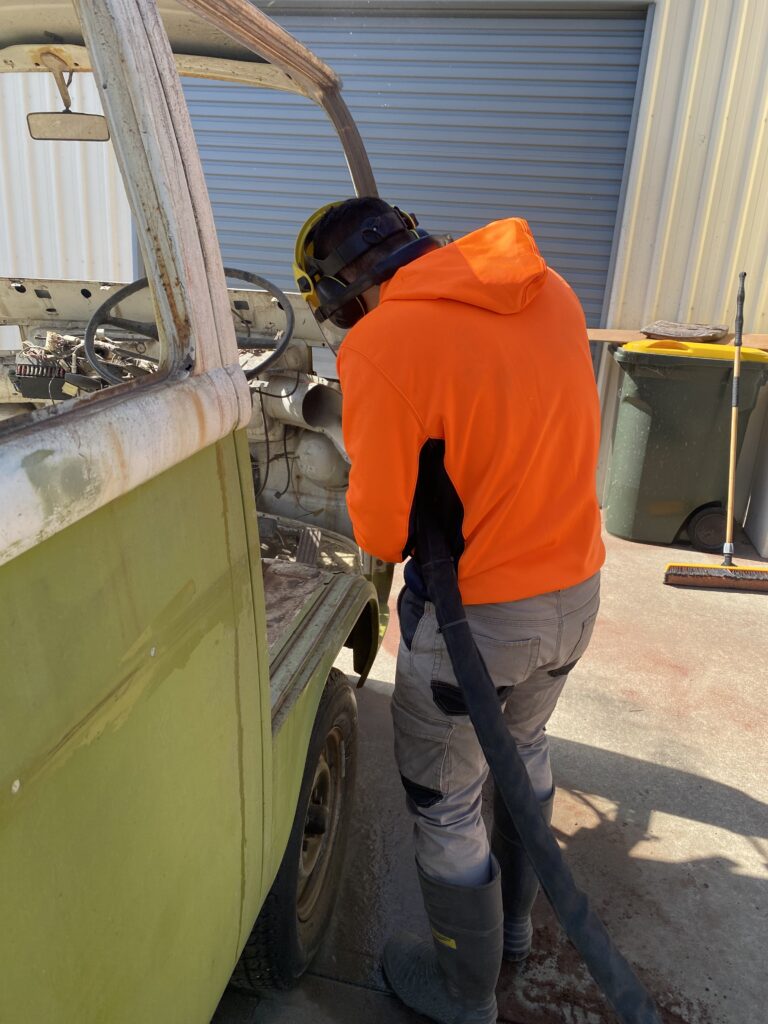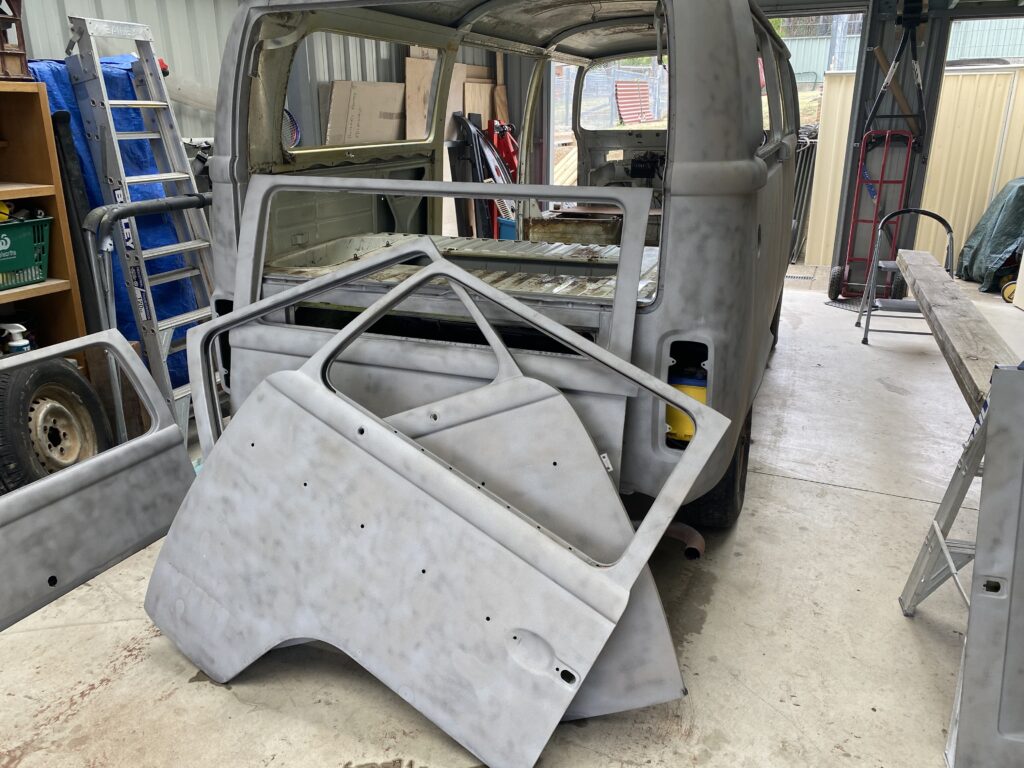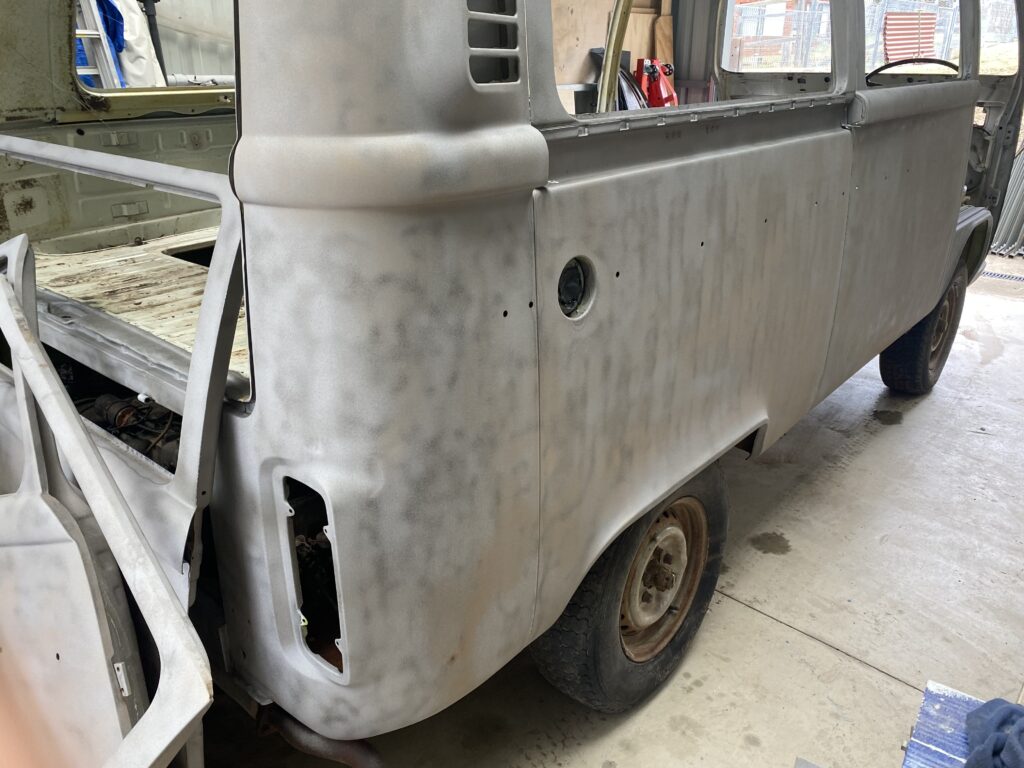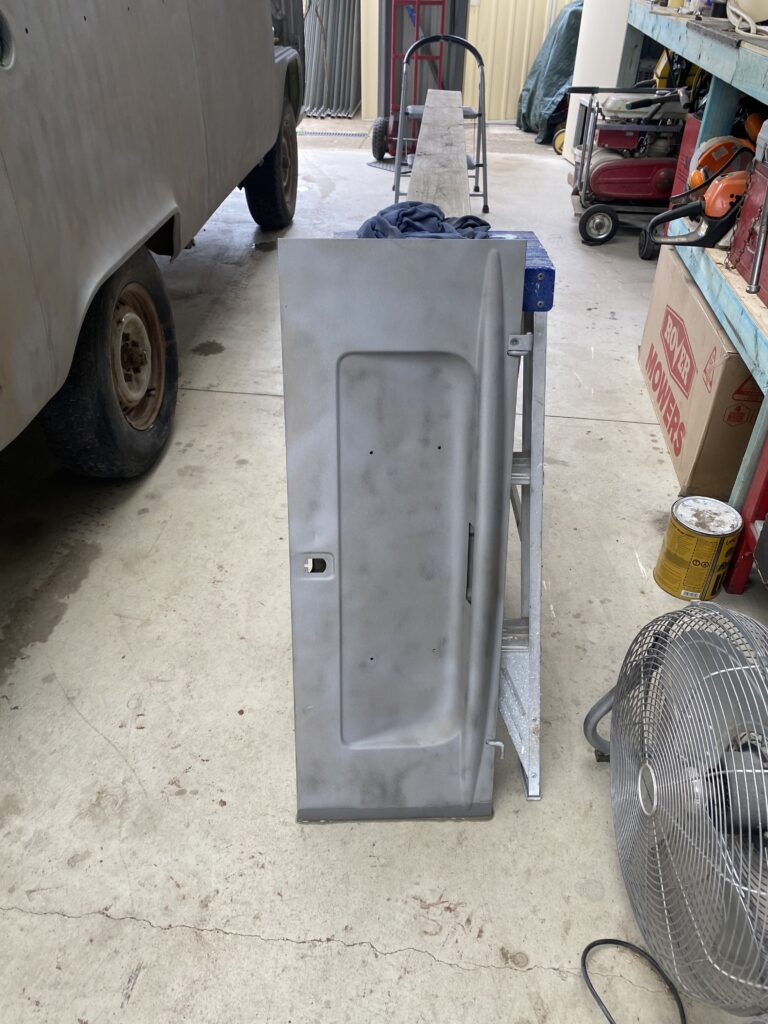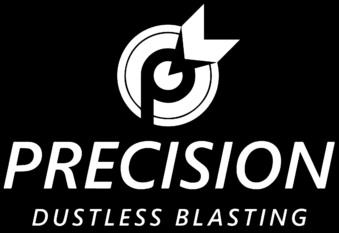Dustless Blasting Process
When it comes to stripping paint, rust, oil and grease from the steel body of a car, a variety of methods can be used including acid dipping, manual sanding, paint stripper, dry sandblasting and wet sandblasting.
The typical problems with surface preparation during automotive restoration are:
• Paint, rust and filler removal is a very slow and laborious process when done manually by hand
• Dry sandblasting causes panel ‘warping’ due to friction and heat
• When the car panel is dipped in acid, it can reach into tiny crevices but some of these are difficult to paint and can rust quickly
• Harsh chemicals used in paint strippers are bad for the health and the environment
• Expensive transport costs to take the vehicle off site to blast
Sandblasting is a very fast and efficient way to remove grease, paint and even the thickest sections of corrosion. Sandblasting can be done dry or wet with the use of water but wet abrasive blasting is found to provide the best surface finish to restore the car back to its glory.
• Water used in the wet blasting process ensures panels do not warp due to the heat and friction and provide a feathered finish
• The equipment is mobile and process can be performed on site anywhere avoiding towing costs
• Fine control and pressure tuning allows adjustment to suit different thickness of surfaces and coatings
• The process is 95% dustfree and safe for the environment
• Safe for the operator to use without the need for expensive personal protective equipment
• Wet blasting less abrasive media, compressed air and power than dry sandblasting
• Effective on hard to reach places that are un-achievable by manual sanding
• Rust inhibitor used in the process provides up to 72hrs protection from flash rusting
• No qualifications required to use it
• Wet blasting will remove body filler in much less time than most other methods
• A washdown after the blast using the RapidHold Rust Inhibitor removes all residue of contaminants and abrasive media
Unsightly graffiti is the bane of modern suburbia can bring down the appearance of any location.
Some people consider it to be a pain to remove paint from concrete /brick walls and particularly removing paint ingrained in timber. They consider the only feasible option is to apply fresh paint over the surface.
Some of the current problems faced with graffiti removal include:
• Harsh chemicals that are used can damage the substrate and can be incredibly bad for the environment.
• High pressure water blasters use a staggering amount of water that is not only wasteful but also is not feasible for all locations.
• Painting over may not mask the graffiti and may make it look worse.
But there is a simpler way and you will be surprised that it is not new technology. It has been around for many years but the versatile technology is finding innumerable new applications including graffiti removal. It is known as wet abrasive blasting or dustless blasting and it makes the job a lot easier than you imagine.
The advantages of using wet abrasive blasting to remove graffiti are:
• It is very flexible and adaptable to the substrate and the coating. It can use a multitude of different sand blasting media such as garnet, soda and crushed glass.
• The media used is completely inert and safe to the environment.
• The controls on the machine that can be fine tuned to use the optimal level of abrasive and pressure to achieve the desired finish. High pressure cleaning tends to remove the mortar from bricks and damage the surface.
• As compared to high pressure water blasting that uses upto 17 litres of water per minute, the RapidBlast SD140 uses just 1.7 litres of water.
• By suppressing the plume of dust and avoiding harsh chemicals, you can work safely in almost any urban environment without containment and minimal disruption. There is no damage to surrounding vegetation.
• Last but not least, dustless blasting is far more efficient than other conventional means resulting in saving in time and cost.
No need for large containment set up (refer to local epa and council guidelines) – Far greater adjustable pressure range (you can literally dial it down low enough to sandblast the paint off a coke can without damaging it. – You are completely mobile!!
There are a range of videos and photos available all over the internet.
But here’s one to get you started.
Flash rusting can present a significant problem when preparing metal structures for coating and painting, as it forms very quickly on steel that has been newly blasted, especially when sandblasting or other conventional dry blasting are methods are used. If not checked and controlled, flash rusting can fatally undermine the integrity of steel marine structures, boats, ships and machinery and cause protective coatings to fail.
Flash rust is caused by salt deposits on the surface of newly-blasted metal (a constant hazard in marine environments) which, when mixed with water, cause corrosion cells to form. The problem is exacerbated and accelerated in humid environments.
In dry blasting, the sandblasting media is not rinsed off leaving soluble salts and other contaminants on the surface to a certain degree.
In wet abrasive blasting, a slurry of water and sandblasting media is propelled at high pressure onto the surface. A combination of the blast media cushioned by water removes the coating/corrosion but soluble salts are not left on the blasted surface as the water dissolves them and then washes the salt away.
The use of a rust inhibitor such as RapidHold™ SuperStrength provides additional protection against flash rusting for upto 72 hours. The rust inhibitor can be added to the slurry mix of water and sandblasting media while blasted. The RapidBlast™ wet blasting machine also has an option for wash down whereby the surface can be rinsed off using the solution of the rust inhibitor mixed with water. The RapidBlast™ abrasive blasting equipment also has an option of remote washdown whereby the washdown can be activated and controlled from the deadman handle itself without having to go back to the control box on the dustless blasting machine to change the controls.
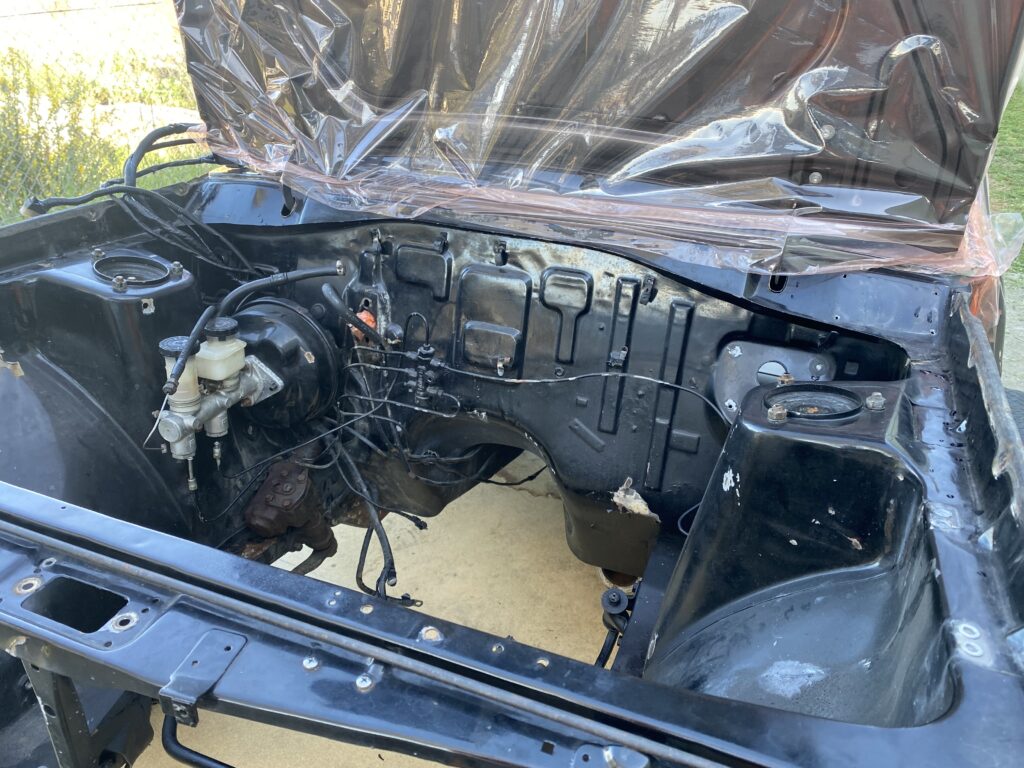
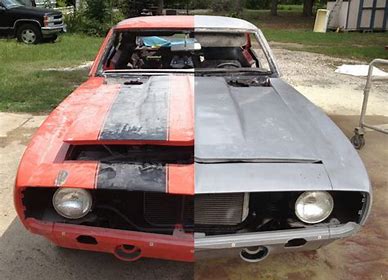
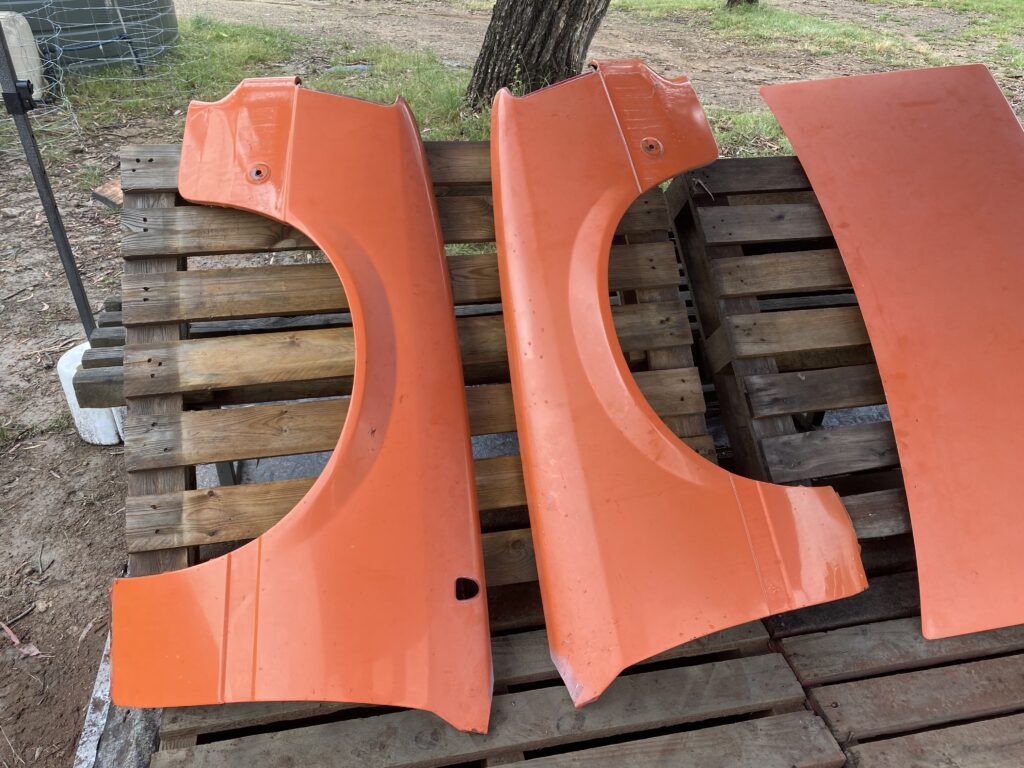
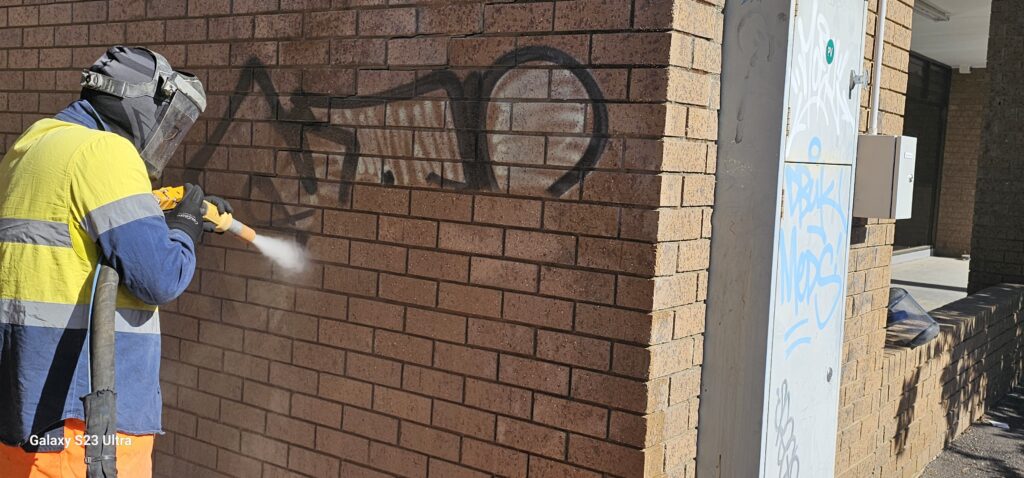
Compared to other processes, wet abrasive blasting or dustless blasting has the following advantages for the restoration of wood:
• The use of water suppresses the dust and makes it safe for the environment, the operator, and the others in the area.
• A wet abrasive blaster is a multi-media dustless blaster, consumes less abrasive media, and its low water consumption makes it environmentally friendly.
• Wet abrasive blasting is efficient and impactful as the water particles encapsulate the abrasive media and the saturated media creates a forceful impact removing the coating easily.
• The blast force can be varied based on the surface being blasted and it can be gentle and mild on the wooden surface to remove paint, shellac, epoxy, lacquer, acrylic paint, polyurethane, varnish, paper, grime, mildew or mold, stains, paint, weathering, fire damage, or any contaminants without damaging the wooden surface.
• Dustless blasting can reach all corners and nooks of the wooden object to clean them perfectly.
• Wet abrasive sandblasting is capable of restoring a 100-year-old barn or furniture or a log home or any wooden object.
• Dustless blasting is efficient and safe for wood stripping and restoration.
• Wet abrasive blasting does not have the harshness or aggressiveness of dry sandblasting, and it works gently and mildly on a wooden surface.
• Dustless blasting has enough power to strip off years of old coating, weathering, and grime but is gentle enough to preserve the integrity of the wood.
• Wet abrasive blasting has mobility and can be taken anywhere including for cleaning an old barn.
• Dustless blasting or wet abrasive blasting can be used for etching designs on the wood.
• Wet abrasive blasting can work on soft woods like pine, cedar, and redwood, and hardwoods like oak, maple, and walnut.
• Different abrasive media can be used viz. crushed glass (Mohs hardness 5 to 6), soda bi-carbonate (Mohs hardness 2.5), fine glass beads (Mohs hardness 5 to 6), and fine garnet (Mohs hardness 7.5 to 8.5). The selection of the abrasive media is made based on the condition of the wood. Soda bi-carbonate is a single-use media. Crushed glass is made from recycled bottle glass, and is economical, clean, and environmentally friendly.
• The expert’s advice is to keep more standoff distance when wet abrasive blasting a substrate like wood and keep the nozzle moving, to avoid profiling. Adjust the blast pressure for delicate work.
Manufacturing is a vast field across multiple industries such as automobiles, machine tools, metallurgy, chemicals, steel etc and can range from small scale to huge complex machinery involving the use of expensive industrial equipment and infrastructure. Manufacturing companies aim to minimize unit production costs and cut down on capital expenditure by running their machinery as long as possible and as high capacity as demand permits. However, this results in a significant amount of wear and tear of equipment. Therefore, companies must conduct frequent maintenance and keep the equipment in good condition to increase asset longevity. Most machinery is built from metal which requires surface preparation prior to installation as well as regular maintenance to keep in good condition. This could involve surface cleaning, surface preparation for painting or powder coating, stripping of corrosion, stripping of mill scales on the metal surface, removing burrs and sharp corners from machined components, and similar works.
Manufacturing is a heavy-duty, highly demanding industry, and machines are put through a high amount of wear and tear during production and therefore, maintenance is required regularly to improve the longevity of these expensive machineries. Corrosion is a multi-billion dollar problem in the manufacturing industry due to the susceptibility of steel to moisture and chlorides. In addition, there is often a large buildup of surface contaminants, such as oil and grease that need to be cleaned before the machine can be repainted.
A quick and effective method of maintenance is required to minimize the time in which production is halted.
After the fabrication of large metal components like the body of machines, chassis of a truck, trailer components and similar items, the metal surfaces needs to be prepared for painting. The different processes available for surface preparation are manual grinding/sanding, high-pressure washing, chemical cleaning, and sandblasting. The manual processes are slow and require precise skill to achieve the required surface finish. Chemical cleaning is quick and cheap but can be hazardous to the operators and the environment. Dry sandblasting is efficient and the media can be easily reused whereas wet abrasive sandblasting is portable and can be done without a blast booth or containment facilities.
With protracted use, engines may require reconditioning and the work involves stripping the engine, cleaning the engine block, engine head, transmission parts, refurbishing all the parts, and then reassembling with the required new parts. Abrasive blasting can be used to clean the parts and thereby extend the useful life of the equipment.
